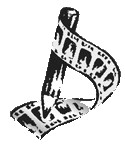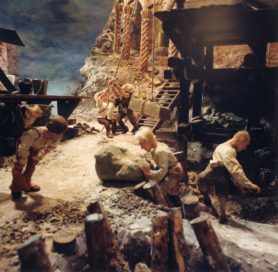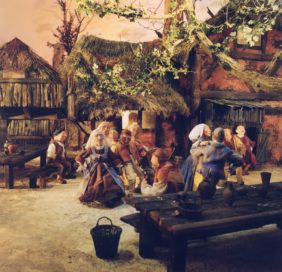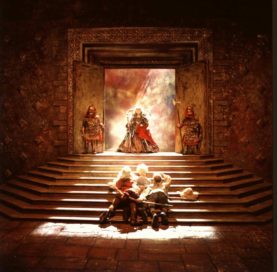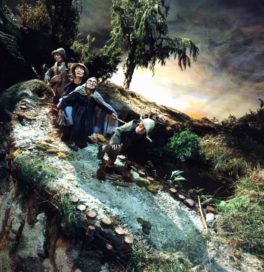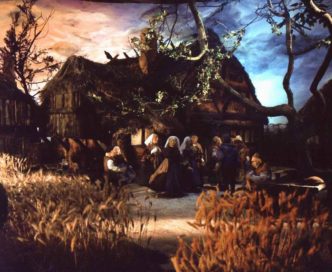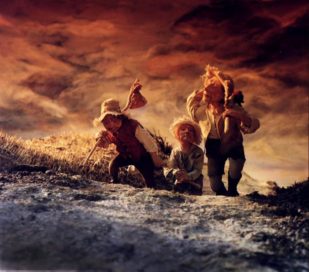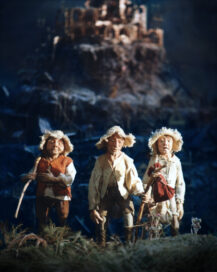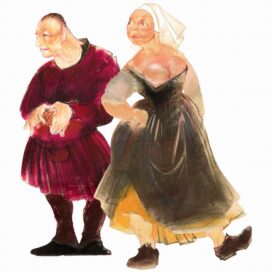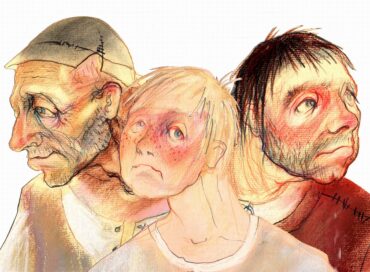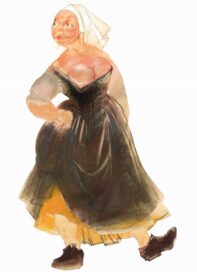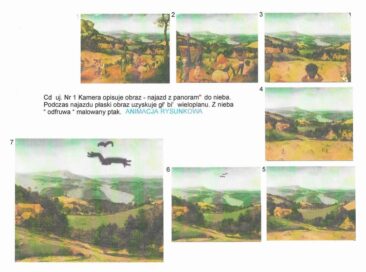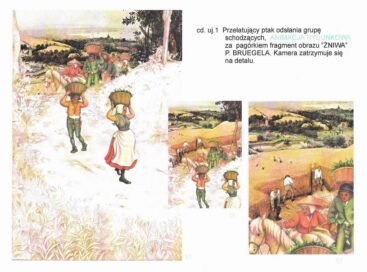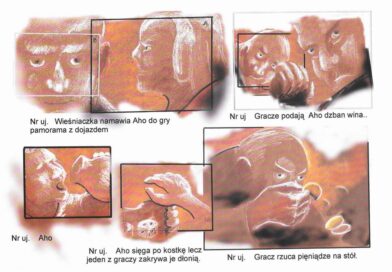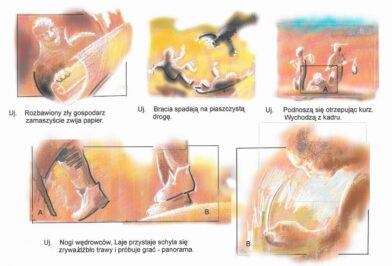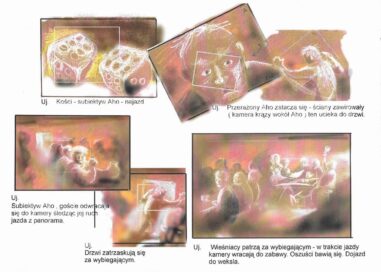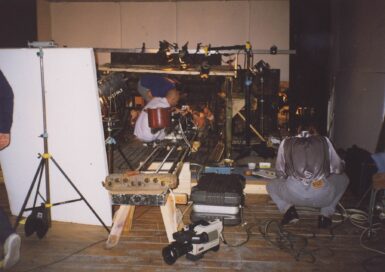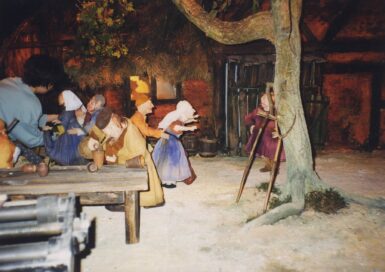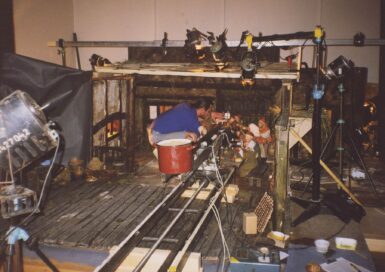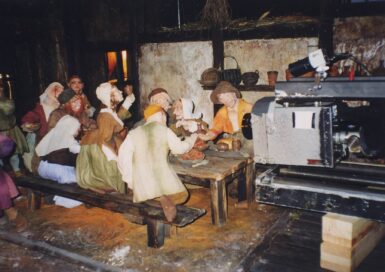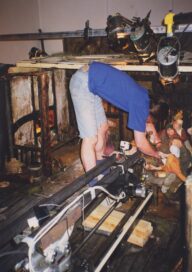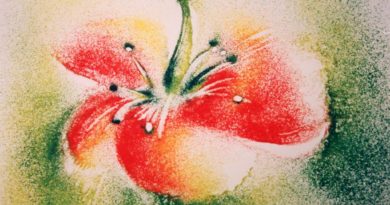Of the Quarrel of All Quarrels
Film from the “Fourteen Tales from Lailonia Kingdom by Leszek Kołakowski” series, based on the philosophical parables „Tales from Lailonia Kingdom for the Big and Small” by Leszek Kołakowski.
The heroes of the film are three brothers: Eino, Aho and Laje. They earn their daily crust working their family land. Eino works from dawn till dusk. Aho likes to have a good time in the local inn and Laje sometimes helps Eino and sometimes accompanies Laje. One day Aho was cheated at dice and lost the farm.
The brothers set off in search of work. They arrive at a road trifurcating. Eino wants to go left, Aho right and Laje keeps switching sides. Unable to convince each other the brothers start a mighty quarrel. In the end, afraid to walk alone they decide to keep together and go down the road chosen by Eino. Together they travel through forests, fight wild animals and forage for food. In the end they arrive at the gates of the city from Eino’s dreams. However, it turns out that that the only work they can beg to get is at a building site of a new palace and they have to work for food. They toil from dawn till dusk. Disenchanted, Aho dreams of the land of happiness, which in his opinion lies at the end of the road he thought they should have taken. Aho gets to the road’s trifurcating. The remaining brothers do not hear anything about his fate for a long time and in the end they get the news of his death. Eino tries to convince Laje to stay with him in the city. But after a while Laje too decided to set off in search of a better city.
OF THE QUARREL OF ALL QUARRELS | O NAJWIĘKSZEJ KŁÓTNI
Directed, camera by Zbigniew Kotecki
Script, dialogue by Jan Zamojski
Set, Puppets, Costumes by Maria Balcerek
Music composed by Marcin Pospieszalski
Music performed by Marcin Pospieszalski–violin,singing, Joszko Broda–pipe, bagpipes, leaf, straw; Marta Stanisławska -dulcimer; Piotr Żyżelewicz–conga; Angelika Górny–singing
Animation by Krzysztof Brzozowski, Adam Wyrwas
Choreography by Izadora Weiss
Editing by Teresa Miziołek
Sound by Wiesław Nowak
Puppets made by Dariusz Kalita
Props made by Jacek Spychalski
Set made by a team headed by Maria Balcerek: Małgorzata Wolańska, Krzysztof Brzozowski, Jacek Spychalski, Sylwia Nowak, Dorota Dubiak, Magdalena Chruszcz, Katarzyna Sierżant, Leszek Jaroszewki, Roman Piwocki, Maciej Dauksza, Wiktor Dzwoniarek
Voices: Narrator-Zbigniew Zapasiewicz; Eino-Andrzej Arciszewski; Aho-Marek Frąckowiak; Laje-Paweł Iwanicki; and Beata Kawka, Joanna Orzeszkowska, Elżbieta Bednarek, Tomasz Bednarek, Paweł Szczesny, Robert Tondera, Włodzimierz Bednarski
Production Manager by Ewa Sobolewska
Series executive director by Maciej Wojtyszko
Series editor by Anna M. Zaremba (TV SFA)
Series editor by Krystyna Chojnicka(TVP SA)
The film made in the puppet animation technique: 35 mm, colour, 501 m, 18:20 min.
Production date: 22.11.1999 © TV SFA – TVP SA 1999
Premiere: December 3, 1999 in “Polonia” cinema in Łódź during the official opening of the Exhibition of Puppets and Set in the Museum of Cinematography in Łódź.
Awards:
CHILDREN’S JURY AWARD from the best animated film, 22nd International Young Audience Film Festival Ale kino!, Poznań, Poland, 2004
HIGH COMMENDATION for the film, 10th Cairo International Children Film Festival, Cairo, Egypt, 2000
SECOND PRIZE to the director of the film, First Meeting with Documentary and Animation Films “DAF 2000”, Szczecin, Poland, 2000
SILVER POZNAŃ GOATS AWARD for the best animated film, National Competition, 18th International Festival of Films for Children Ale kino!, Poznan, Poland, 2000
POZNAŃ GOATS AWARD, to the author of the best design in animation film, National Competition, 18th International Festival of Films for Children Ale kino!, Poznan, Poland, 2000
POZNAŃ GOATS AWARD to the author of the best design in animation film, International Competition, 18th International Festival of Films for Children Ale kino!, Poznan, Poland, 2000
POZNAŃ GOATS AWARD for the music, National Competition, 18th International Festival of Films for Children Ale kino!, Poznan, Poland, 2000
POZNAŃ GOATS AWARD, for the animation, National Competition, 18th International Festival of Films for Children Ale kino!, Poznan, Poland, 2000
MARCINEK CHILDRENS’ JURY AWARD, for the film, International Competition, 18th International Festival of Films for Children Ale kino!, Poznan, Poland, 2000
MARCINEK CHILDRENS’ JURY AWARD for the directing, National Competition, 18th International Festival of Films for Children Ale kino! Poznan, Poland, 2000
MARCINEK CHILDRENS’ JURY AWARD for the best design, National Competition, 18th International Festival of Films for Children Ale kino!, Poznan, Poland, 2000
SECOND PRIZE for the best animation film, Millenium Film Festival of Fine Arts, Szolnok, Hungary, 2000
BEST ANIMATED FILM AWARD, 5th International Short Film Festival, Siena, Italy, 2000
SILVER LINE for remarkable artistic values, VI National Festival of Auteur Animation Films OFAFA’2000, Cracow, Poland, 2000
PRESS AWARD – „MY OSCARS” granted by Professor Marek Hendrykowski: To Jan Zamojski (script-writer), Zbigniew Kotecki (director, director of photography) and Ewa Sobolewska (production manager) for the film ‘Of the Quarrel of All Quarrels’ (based on a parable from the series ‘Tales from the Lailonia Kingdom for the big and small’ by Leszek Kołakowski, made by Television Studio of Animation Films in Poznań., Poznań, Poland, 1999
ART PROJECTS BY MARIA BALCEREK AND STORYBOARD BY ZBIGNIEW KOTECKI
GENERAL INFORMATION ON PUPPETS AND SET
PUPPETS
Size: 52 cm.
Puppets are made of latex [sculpture made of plasticine, plaster cast, process of compressed latex burning];
14 basic structures – “anatomic” puppet skeletons with full animation-movement capabilities;
22 simplified structures;
36 persons participate in crowd scenes;
Skeleton construction of puppets was adjusted to the requirements the full frame-by-frame animation (24 frames/sec.)
The puppets have:
– moving eyes and eyelids
– moving jaws
– full facial expression, capability of blowing the cheeks
– capability of breathing with the chest
– wigs and facial hair
Puppet costumes were made of natural fibres [linen, wool, cotton, leather].
SET
– 9 main indoor sets
– average size of decorations: 4-5 m wide, 5 – 6m deep, 3 – 4 m high
– set made of wood, wicker and plaster, cocoa fibre and dried corn, grass, moss and forest undergrowth, branches and natural roots
– size of the hand-painted background: 4 m x 7.5 m
– set foundations made of modules – various elements can be joined to make new sets.
PHOTOGRAPHY
Manual Animation – frame-by-frame [24 frames/ sec.] made by 2 animators
Crowd scenes photographed with 2 cameras
Trick shots made with CRASS camera on Eastman Kodak negative Vision 35mm/ 320 ASA
Puppets, set, costumes and props were inspired by the following paintings of Peter Bruegel I:
“Haymaking”, 1565; “The Corn Harvest”, 1565; “The Wedding Dance in the Open Air”, 1566; “The Peasant Dance”, 1568; “The Peasant Wedding Banquet”, 1568; “The Parable of the Blind”, 1568; “The Land of Cockaigne”, 1567; “The Tower of Babel”, 1563
PHOTOS FROM THE FILM SET
